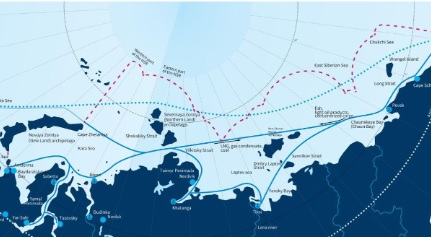International Relations
India's Interest Arctic Region and the Northern Sea Route
- 26 Aug 2023
- 7 min read
For Prelims: Arctic Region, Northern Sea Route, India’s Energy Security, UN Sustainable Development Goals, Himalayas, Suez Canal, Chennai-Vladivostok Maritime Corridor.
For Mains: India's Interest Arctic Region and the Northern Sea Route.
Why in News?
Murmansk, popularly called the capital of the Arctic Region and the beginning point of the Northern Sea Route (NSR), is witnessing the rising trend of Indian involvement in Cargo traffic.
- In the first seven months of 2023, India got a share of 35% of eight million tonnes of cargo handled by the Murmansk port, which is about 2,000 km northwest of Moscow, Russia.
What is the Significance of the Arctic for India?
- Untapped Hydrocarbon Reserves:
- The region constitutes the largest unexplored prospective area for hydrocarbons remaining on the earth. It is estimated that the region may hold over 40% of the current global reserves of oil and gas.
- The region has rich deposits of coal, gypsum and diamonds and also substantial reserves of zinc, lead, placer gold and quartz.
- The Arctic can therefore potentially address India’s energy security needs and deficiency of strategic and rare earth minerals.
- However, the government’s Arctic Policy of 2022 mentions that the country’s approach to economic development of the region is guided by UN Sustainable Development Goals.
- India's Historical Engagement:
- India's engagement with the Arctic dates back to the signing of the Svalbard Treaty in 1920.
- India has conducted various scientific studies and research in the region, focusing on atmospheric, biological, marine, hydrological, and glaciological studies.
- Initiatives like the Himadri research station, multi-sensor moored observatory, and northernmost atmospheric laboratory showcase India's commitment to Arctic research.
- Becoming an observer-state of the Arctic Council in 2013 strengthened India's Arctic presence.
- Geographical Significance:
- The Arctic helps circulate the world's ocean currents, moving cold and warm water around the globe.
- Also, Arctic sea ice acts as a huge white reflector at the top of the planet, bouncing some of the sun's rays back into space, helping keep the Earth at an even temperature.
- Environmental Significance:
- The Arctic and the Himalayas, though geographically distant, are interconnected and share similar concerns.
- The Arctic meltdown is helping the scientific community to better understand the glacial melt in the Himalayas, which has often been referred to as the ‘third pole’ and has the largest freshwater reserves after the North and South poles.
- Therefore, the study of the Arctic is critical to Indian scientists. In line, India launched its first scientific expedition to the Arctic Ocean in 2007 and opened the Himadri research base in the Svalbard archipelago (Norway) and has been actively engaging in research there ever since.
What is the North Sea Route (NSR)?
- About:
- The NSR, the shortest shipping route for freight transportation between Europe and countries of the Asia-Pacific region, straddles the Four Seas (Barents, Kara, Laptev and East Siberian Sea) of the Arctic Ocean.
- Running to 5,600 km, the Route begins at the boundary between the Barents and the Kara seas (Kara Strait) and ends in the Bering Strait (Provideniya Bay).
- It offers potential distance savings of up to 50% compared to traditional routes through the Suez or Panama Canals.
- The 2021 Suez Canal Blockage heightened interest in the NSR as an alternative trade route.
- Russia's Role in NSR Development:
- The Arctic's icebound nature necessitates icebreaking assistance for safe navigation along the NSR. Russia boasts the world's only nuclear-powered icebreaker fleet, ensuring year-round operation. Rosatom, the NSR infrastructure operator, oversees this fleet.
- With Russia's ambitious plans to enhance the NSR's cargo traffic, its nuclear icebreaker fleet remains central to the project.
- Driving Factors for India's NSR Engagement:
- The increasing cargo traffic along the NSR, with a growth rate of approximately 73% during 2018-2022, aligns with India's expanding imports of Russian Crude Oil and coal.
- The NSR's potential as a transit route also suits India's trade-heavy economy.
- The Chennai-Vladivostok Maritime Corridor (CVMC) project offers a shorter and efficient trade route, further boosting India's interest in the NSR.
- Additionally, India seeks to balance China and Russia's potential collective influence over the NSR.
- Future Developments and Collaborations:
- Russia's NSR development plan aims for significant cargo traffic growth by 2035. The CVMC project, designed to link India and Russia via the NSR, holds promise for reducing transport times and enhancing trade efficiency.
- A forthcoming workshop between the two countries is expected to provide a platform for advancing the CVMC project.
Way Forward
- India's engagement in the Arctic region and its increasing participation in the NSR underscore its strategic interests in economic security, environmental sustainability, and trade efficiency.
- As the Arctic continues to experience transformations, India's role in the region is likely to evolve, shaping its economic and geopolitical interests on the global stage.
UPSC Civil Services Examination, Previous Year Question (PYQ)
Prelims
Q. The term ‘IndARC’, sometimes seen in the news, is the name of (2015)
(a) an indigenously developed radar system inducted into Indian Defence
(b) India’s satellite to provide services to the countries of Indian Ocean Rim
(c) a scientific establishment set up by India in Antarctic region
(d) India’s underwater observatory to scientifically study the Arctic region
Ans: (d)
Mains
Q.1 Why is India taking keen in resources of Arctic region? (2018)
Q.2 What are the economic significances of discovery of oil in Arctic Sea and its possible environmental consequences? (2015)





